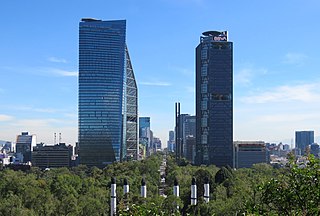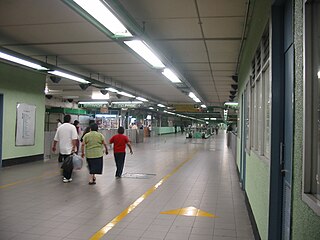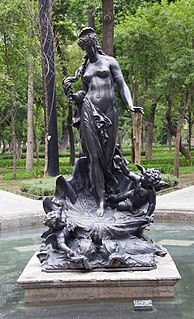
Chapultepec, more commonly called the "Bosque de Chapultepec" in Mexico City, is one of the largest city parks in Mexico, measuring in total just over 686 hectares. Centered on a rock formation called Chapultepec Hill, one of the park's main functions is as an ecological space in Greater Mexico City. It is considered the first and most important of Mexico City's "lungs".

Paseo de la Reforma is a wide avenue that runs diagonally across the heart of Mexico City. It was designed at the behest of Emperor Maximilian by Ferdinand von Rosenzweig during the era of the Second Mexican Empire and modeled after the great boulevards of Europe, such as the Ringstraße in Vienna and the Champs-Élysées in Paris. The planned grand avenue was to link the National Palace with the imperial residence, Chapultepec Castle, which was then on the southwestern edge of town. The project was originally named Paseo de la Emperatriz in honor of Maximilian's consort Empress Carlota. After the fall of the Empire and Maximilian's subsequent execution, the Restored Republic renamed the Paseo in honor of the La Reforma.

Sevilla is a station on Line 1 the Mexico City Metro. It is located in the Cuauhtémoc borough in the centre of Mexico City, on Avenida Chapultepec and Sevilla street. It serves colonias Roma and Juárez.

Insurgentes is a station on the Line 1 of Mexico City Metro. It is located within the Glorieta de los Insurgentes at the intersection of Avenida de los Insurgentes and Avenida Chapultepec in Mexico City's Cuauhtémoc borough, close to the Zona Rosa shopping and entertainment district and the Colonia Roma, two of the most iconic neighborhoods in the city. In 2019, the station had an average ridership of 65,134 passengers per day, making it the 12th busiest station in the network.

Salto del Agua is a metro (subway) station on the Mexico City Metro. It is located in the Cuauhtémoc borough in the center of Mexico City. Starting 9 July 2022, the Line 1 station will remain closed for at least eight months for modernization work on the tunnel and the line's technical equipment.

Mexico City Metro Line 1 is one of the twelve metro lines operating in Mexico City, Mexico. Officially inaugurated in 1969, it went to become the first metro line to be built in the country. Its identifying color is pink and it runs through the city from west to east.

The Chapultepec aqueduct was built to provide potable water to Tenochtitlan, now known as Mexico City. This fresh water was transported from the Chapultepec springs. Two aqueducts following the same route from the springs were built by the Aztecs during the 15th century, the first destroyed by flooding and the second by the Spanish. After the Spanish conquest a colonial aqueduct was built, the ruins of which are located near Metro Sevilla.
Luis Ortiz Monasterio was a Mexican sculptor noted for his monumental works such as the Monumento a la Madre and the Nezahualcoyotl Fountain in Chapultepec Park. His work was recognized in 1967 with the Premio Nacional de Artes and was a founding member of the Academia de Artes.

The Fountain of Cybele in Mexico City is a bronze replica of the fountain located in the Plaza de Cibeles in Madrid that was built during the reign of Charles III by architect Ventura Rodríguez between 1777 and 1792. The Mexican version is located at a traffic circle in Plaza Villa de Madrid, where Oaxaca, Durango, Medellín and El Oro streets converge in Colonia Roma.
Tecamachalco is the common name for a State of Mexico suburban neighbourhood, colonia Lomas de Tecamachalco, which forms part of the city of Naucalpan, in Naucalpan and Huixquilucan municipalities, in the State of Mexico.

The Huntress Diana Fountain is a monumental fountain of Diana located in the roundabout at Paseo de la Reforma and Río Misisipí and Sevilla streets, on the border of the Colonia Cuauhtémoc and Colonia Juárez neighborhoods of Mexico City. Nearby landmarks named after the fountain include the Cine Diana and the skyscrapers Corporativo Reforma Diana and Torre Diana.

The fountain of Venus is installed in Mexico City's Alameda Central, in Mexico.

La Primavera is an outdoor fountain and sculpture installed in Mexico City's Alameda Central, in Mexico. The statue represents Persephone.

Glorieta de Insurgentes is a large roundabout formed at the intersection of Avenida Chapultepec and Avenida de los Insurgentes, in Mexico City. In it flow both Oaxaca Avenue and the streets of Jalapa and Génova, which give access to Colonia Roma Norte for the first and the Zona Rosa of the Colonia Juarez for the latter.

Fuente de los Cántaros is an outdoor fountain and sculpture of an indigenous woman in Mexico City's Parque México, in Mexico, created by José María Hernández Urbina in 1927, and restored in 2008.

The Fuente de los Niños Traviesos, colloquially known as the Fuente de los Niños Miones, is a fountain with sculptures of boys in Guadalajara, in the Mexican state of Jalisco.

Inmolación de Quetzalcóatl is a fountain and sculpture by Victor Manuel Contreras, installed in Plaza Tapatía, in Centro, Guadalajara, in the Mexican state of Jalisco.
Fuente Olímpica is a fountain and sculpture in Guadalajara, in the Mexican state of Jalisco.

The Fuente de la República is a carbon steel fountain and sculpture installed in Mexico City, Mexico. It was inaugurated on 13 December 2007 by Marcelo Ebrard, the Federal District's head of government, and was placed at the intersection of Avenida Paseo de la Reforma, Avenida Juárez and Avenida Bucareli, in the Cuauhtémoc borough. The fountain was created specifically for the celebrations of the 200th anniversary of the country's independence in 2010. It was designed by Manuel Felguérez, who also designed the Puerta 1808 sculpture found in front of it.

















